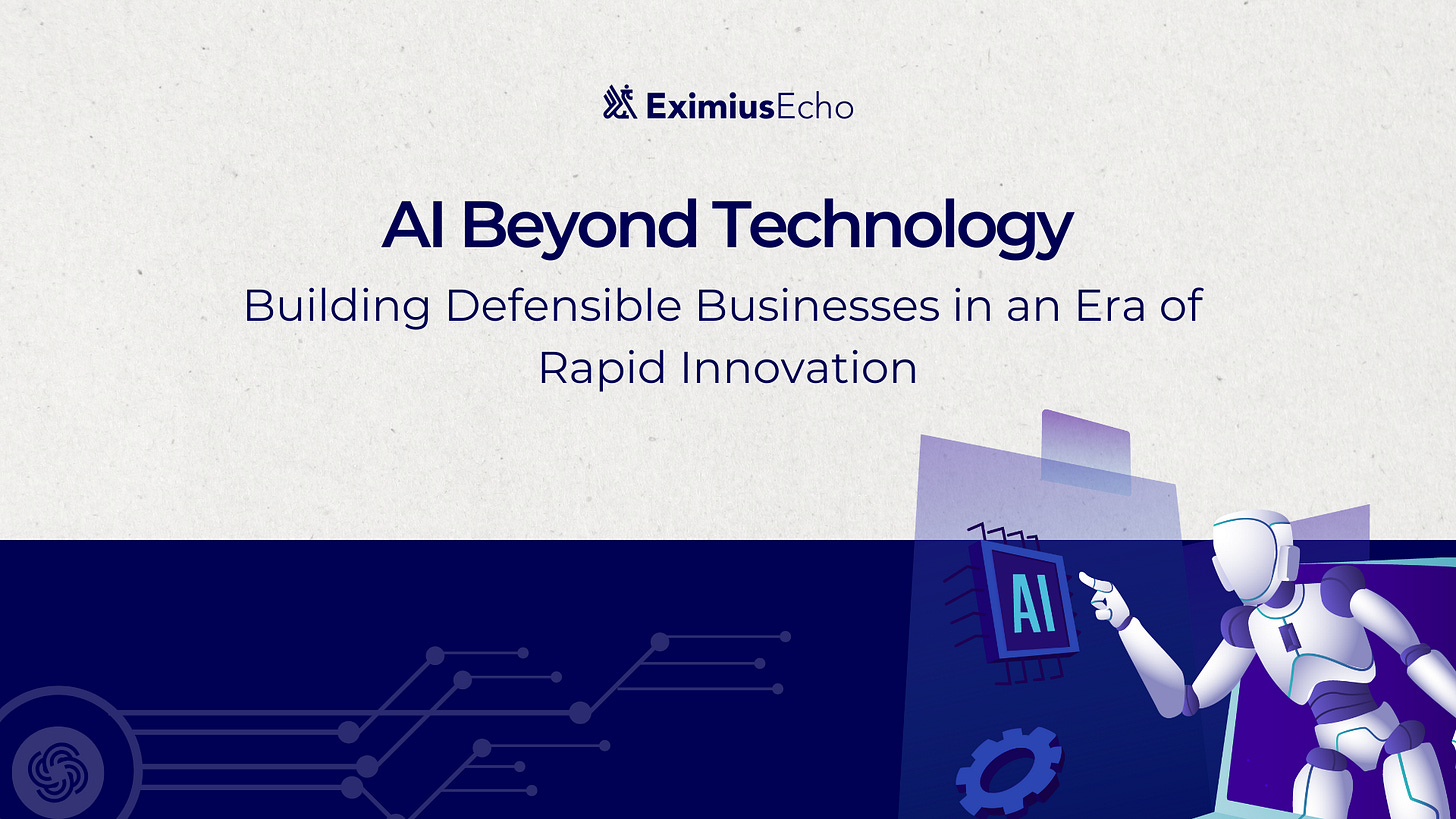AI Beyond Technology: Building Defensible Businesses in an Era of Rapid Innovation
The AI landscape evolves at a dizzying pace, with new breakthroughs in models, architectures, and frameworks emerging almost daily.
Hi there!
This week on Eximius Echo, we dive into the rapidly changing world of AI, exploring how companies can build defensible businesses in an era of constant innovation. We’ll discuss how advancements in AI models and architectures are coming fast and furious, and how businesses can go beyond just adopting the latest tech to create sustainable, competitive advantages.
If you’ve not heard of us, Eximius is a pre-seed stage VC fund focusing on fintech, AI/SaaS, frontier tech, and consumer tech. You can find out more here. This newsletter is an attempt to share ideas, insights, and context within the realms of our chosen sectors. Let’s dive in.
The AI landscape evolves at a dizzying pace, with new breakthroughs in models, architectures, and frameworks emerging almost daily. However, for real-world application companies, technology alone rarely secures lasting advantages. Even advanced AI capabilities quickly become table stakes. The critical question becomes: in a space where underlying technology rapidly commoditises, how do companies build sustainable, defensible businesses?
Rethinking Competitive Advantages
Over the past year, many AI startups have emphasised proprietary data and custom architectures as their competitive advantages. However, the rapid evolution of LLMs has made these claims increasingly tenuous. True defensibility in AI often stems from deep system integration, personalisation, effective distribution, domain expertise, and exceptional user experiences.
Overhyped Defenses
1. Proprietary Datasets:
During the very early days of mainstream generative AI hype until 2023, generative AI founders emphasised data moats. Many built their own models or acquired large datasets for specialised fine-tuning and reinforcement learning. This tactic worked early on, allowing them to differentiate in narrow domains. However, the release of GPT-4 changed the landscape. With a larger model size, expanded context window, and 90–95% accuracy across many tasks, GPT-4 required less extensive fine-tuning to achieve strong performance. Even datasets once considered unique—such as specialised radiology images or legal contracts—lost some of their moat value as models trained on broad data rivalled domain-specific accuracy. A more durable defence is a “closed-loop” system that continuously captures client-specific outcome data. Over time, that personalised history becomes a barrier to replication.
2. Custom Architecture:
Some startups promote novel architectures or techniques they believe are difficult to replicate. In reality, AI research is highly open and fast-moving. Breakthroughs often appear in open publications, and talented engineers move quickly between firms. Even notable innovations like FlashAttention, created by Tri Dao to optimise memory usage in transformer attention, were integrated into major frameworks within months. Techniques such as Chain-of-Thought (CoT) have similarly been absorbed into newer releases, like OpenAI’s o1. The voice domain has followed suit: cascading architectures (transcribing speech to text, sending it to an LLM, and converting text back to speech) are already being replaced by LLMs like GPT-4o that support speech natively. Ultimately, custom architectures can serve as helpful stopgaps, but they lose relevance as foundational models grow more capable.
Genuine Competitive Advantages
1. Distribution and Domain Expertise:
Companies with privileged access or relationships gain a powerful distribution advantage. Abridge, for instance, benefits from its partnership with Epic in delivering AI scribe solutions, granting it direct pipelines to hospitals and clinics. Founders that bring in strong C-suite access likewise enjoy an early distribution advantage, securing pilot programs and scaling beyond experimental budgets.
Likewise, in deeply regulated or traditional sectors, domain expertise matters more than baseline AI capabilities. Sectors like legal, health and manufacturing still rely heavily on phone calls, emails, and spreadsheets, so any software solution requires intricate knowledge of procurement, compliance, and user behaviour to achieve penetration. That know-how, not the AI algorithm alone, becomes the differentiator.
2. Workflow Integration:
AI-native platforms that capture data at its source can begin as middleware and gradually usurp legacy systems. Liberate, for example, fields insurance claims through AI voice agents, initially integrating with Guidewire but gathering enough real-time data to one day supplant it. Similarly, Fixify handles IT issues at the point of customer contact, tapping into data before it enters a tool like ServiceNow. By controlling data flows and embedding themselves into crucial processes, these companies make it difficult—and expensive—for customers to switch.
3. Deep Personalisation:
Systems that learn from a client’s unique history create a personalised “memory” not easily replicated elsewhere. An AI sales agent that refines its approach based on a specific client’s prospect data offers insights another platform cannot simply inherit. This effect is strongest where variability is high and past interactions significantly influence outcomes, discouraging customers from abandoning their built-up history.
4. Niche Differentiation:
Markets can sustain multiple winners if each specialises in a different vertical or niche. While Sierra and Liberate both offer AI-driven support, Liberate zeroes in on insurance integration with platforms like Guidewire. By catering to the specific compliance and workflow demands of insurance, it gains a foothold that a more generic provider would find challenging to replicate.
5. User experience:
In the rush to launch AI products, many founders overlook the fundamentals of good product design and engagement. Perplexity, a generative search platform, wins due to its clean interface and intuitive experience, encouraging repeat use. Cursor is another prominent example: although it also calls Anthropics’ models under the hood, one of its core innovations lies in a simple yet powerful UX that lets engineers view code diffs and apply them with one click. That usability propelled Cursor to over $100 million in ARR and a $2.6 billion valuation. Github Copilot’s success also owes much to seamless UX—users continue coding as usual while the tool unobtrusively suggests improvements.
These patterns reveal an important truth: evaluating AI-native applications follows many of the same principles we've long applied to traditional SaaS. The fundamentals of building defensible businesses remain largely unchanged.
Strategic Approaches Across Domains
Within the broad AI landscape, agentic applications often fall into three categories: horizontal, functional, or vertical
1. Horizontal Agents
Horizontal agents like AI-powered note-taking or CRM tools—have broad applicability across roles and industries. To survive in this crowded space, frictionless user experience and deep integration into existing workflows are paramount (think 10x better experience). Distribution deals also create an important competitive advantage, though dependence on distributors carries the risk of marginalisation if they launch equivalent native features, as seen in the competition between Otter and Google's Gemini-powered note-taking capabilities.
2. Functional Agents
Functional agents specialise in specific enterprise functions, such as customer support or sales. In this category, distribution effectiveness serves as a crucial differentiator, closely tied to the quality of the founding team. Development speed (for example, shipping velocity) represents another key competitive advantage. For instance, Decagon, focusing on customer support, releases feature updates weekly, attracting clients seeking to reduce call-center costs. While their product may not be uniquely innovative, their rapid improvement cycle and strong customer relationships ensure market sustainability.
3. Vertical Agents
Vertical agents tackle specialised, regulated fields like healthcare and law. Companies like Silna in health often succeed because they understand complex compliance requirements and deeply ingrained purchasing processes. Though they may benefit from partial data moats—especially when they accumulate specialised datasets over time—the real advantage lies in speaking the language of arcane regulations and integrating with industry-standard systems. Vertical players can even build entirely new systems of record, capturing workflows from day one and embedding themselves so thoroughly that displacement becomes nearly impossible.
Conclusion
As AI technology rapidly evolves, true competitive advantage now lies in factors beyond just proprietary data or custom models. Sustainable businesses are built through deep system integration, personalised experiences, strong distribution channels, and domain expertise. Companies that focus on seamless workflow integration, user-centric design, and niche differentiation will be better positioned to thrive, as technology alone becomes increasingly commoditised. Ultimately, success in AI is about building lasting value through unique, adaptable solutions that meet specific industry needs.
If you are looking to build for any of these problem statements or any other space within AI/SaaS, please reach out to us at pitches@eximiusvc.com.










